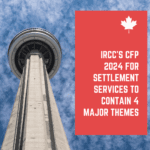Canada’s immigration ministers meet in Toronto; four provinces hold PNP draws
Immigration Minister Marc Miller met yesterday in Toronto with provincial and territorial immigration ministers to discuss shared priorities.
The Federation of Ministers Responsible for Immigration (FMRI) is a group of ministers who meet twice a year. The FMRI is a decision-making body whose objective is to promote Canada’s flexible, fast, and successful immigration system. The objective of the FMRI is to advocate shared immigration interests and improve Canada’s immigration policy and programs.
What the FMRI discussed about on November 17, 2023
Following the meeting, Minister Miller held a press conference in which he reiterated many of the points made during the release of the Immigration Levels Plan 2024-2026 and explained why his department believes the Plan will help create sustainable population growth in Canada while providing much-needed support in the healthcare and construction sectors.
Following the conference, federal and provincial immigration ministers issued a statement outlining important issues of discussion, including:
- Reducing duplication among federal-provincial economic class immigration programs and reducing processing times
- Supporting Francophone immigration outside Quebec
- Delivering a more responsive, client-centred economic immigration system
- Reducing barriers and streamline foreign credential recognition
- Exploring how governments can work together to address pressures on housing, infrastructure and social services
- Considering expanding settlement services eligibility, particularly among asylum claimants and temporary residents on a clear path to permanent residence
- Improving the integrity of Canada’s International Student Program
- Aligning work permits with provincial-territorial labour market needs
Plan for multi-year provincial levels
The most recent FMRI meeting was held in Halifax in March.
The FMRI discussed the approval of a multi-year development strategy for the Provincial Nominee Program (PNP) at the Halifax conference.
This means that provinces and territories will get PNP allocations up to three years in advance. Previously, provinces were only told how many immigrants they may pick for the PNP one year at a time.
A multi-year plan can help provinces by ensuring that they can offer adequate settlement services, housing, healthcare, and other infrastructure for newcomers while also balancing the requirements of those who already live in the province.
Other pertinent problems considered at the time included strengthening foreign education recognition and making it easier for high-demand professionals, such as those in healthcare and construction, to begin working in Canada sooner.
They also talked about expanding the Atlantic Immigration Program as well as the Rural and Northern Immigration Pilot Program.
Canada’s new immigration strategy
Provincial goals tend to coincide with those of the federal government. Immigration, Refugees, and Citizenship Canada (IRCC) has published A New Immigration System for Canada’s Future.
IRCC cites expanded consultations with provincial governments and other partners and stakeholders in the Strategy to help adopt a whole-of-government approach to support sustainable levels of immigration that will strengthen Canada’s economy and workforce.
This strategy was also used in the development of the federal Immigration Levels Plan 2024-2026. In both 2025 and 2026, Canada will admit up to 500,000 new permanent residents per year. 110,000 will enter through the PNP in 2024, and 120,000 will enter through the PNP in 2025 and 2026.
Immigration is a joint responsibility.
Because immigration is a shared obligation under the Canadian Constitution, IRCC collaborates closely with the provinces and territories. Provinces can pick some of the economic immigration applicants who are most likely to boost local economies and integrate into the provincial workforce under the Immigration and Refugee Protection Act (IRPA), the legislation that controls Canada’s federal and provincial immigration systems.
Having said that, it is still up to IRCC to decide whether a nominated individual will become a permanent resident of Canada.
Only Quebec and Nunavut lack PNPs. Quebec has a separate arrangement with the federal government that provides the province complete power over economic immigration.
The most recent PNP draw results
The FMRI meeting came after a busy week in which four provinces reported the results of recent PNP draws. The findings are described below:
British Columbia
In the most recent BC PNP draw, held on November 16, more than 219 candidates were invited.
The largest of the five draws invited 116 candidates from the Skilled Worker, International Graduate, Entry Level, and Semi-Skilled streams. Depending on the stream, the minimum score fluctuated from 94 to 115.
The four remaining drawings were for Skilled Workers and International Graduates in specified occupations.
59 early childhood instructors and assistants
- Healthcare
Other high-demand occupations: less than five
Candidates for these draws had to have a minimum score of 60.
BC also launched its first targeted draw for construction workers. With a minimum score of 75, the province invited 12 Skilled Worker and International Graduate candidates.
Manitoba
On November 16, Manitoba asked 301 applicants to apply.
For candidates in three streams, the province staged four draws.
Among Manitoba’s Skilled Workers, 100 candidates with a minimum score of 809 were invited to apply in a general draw for all occupations.
A second draw for Skilled Workers was occupation-specific, taking into account a variety of National Occupational Classification (NOC) categories from healthcare, education, and homecare.
The remaining draws saw 61 candidates from the International Education stream and 48 Skilled Workers from other countries invited with a minimum score of 721.
Prince Edward Island
On November 16, PEI welcomed 141 candidates to the PEI PNP.
The government invited 134 Labour and Express Entry candidates with a minimum EOI score of 55 to work for a PEI Employer.
There was also a small draw for individuals with a Business Work Permit Entrepreneur. To be considered, these seven contenders required to have a minimum score of 80.
In the last 12 months, PEI has welcomed 2527 candidates using these two channels.
Alberta
On November 9, Alberta invited 16 Express Entry candidates. These candidates were in the Dedicated Healthcare Pathway with Alberta Job Offer stream and had to have a Comprehensive Ranking System score of at least 300.
Candidates in this stream who submit their final application can anticipate to wait up to two months for a final decision, according to the Alberta Advantage Immigration Program (AAIP).
#IRCC
#PNP



